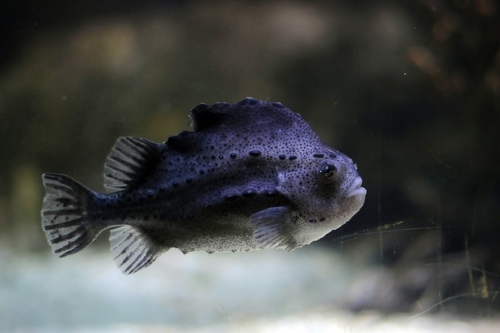
Lumpfish
The Atlantic bluefin tuna (Thunnus thynnus) is a highly migratory, predatory fish renowned for its size, speed, and commercial value. It is a top predator in the marine ecosystem and plays a crucial role in regulating populations of smaller fish and other marine life. Bluefin Tuna are also a culturally significant species.
6 13 years
Lifespan
61 cm
Length
Near Threatened
Conservation Status
5 km/h
Swimming speed
Carnivorous
Diet
Local Migration
Migration
Appearance Overview
The Atlantic bluefin tuna is a large, torpedo-shaped fish with a metallic blue body and a silvery-white belly. It has two dorsal fins, the first of which is usually yellow or blue.
Color
Dark metallic blue on top, silvery-white underside
Body Shape
Torpedo-shaped, streamlined
Fins
Two dorsal fins, first fin yellow or blue, second fin reddish-brown
Finlets
Small, yellow finlets behind dorsal and anal fins
Keel
Strong keel on the caudal peduncle
Length
Up to 13 feet (4 meters), commonly 6.5 feet (2 meters)
Weight
Up to 2,000 lbs (900 kg), commonly 550 lbs (250 kg)
Diet
Carnivorous, feeding on a variety of fish, squid, crustaceans, and eels. They are opportunistic feeders and will consume whatever prey is available.
Feeding Behavior
Highly active predators, bluefin tuna use their speed and agility to chase down prey. They often hunt cooperatively, working together to herd and capture smaller fish.
Social Behavior
Highly migratory, forming large schools that can travel vast distances across oceans. They often segregate by size, with smaller fish forming larger schools and larger fish forming smaller groups or traveling alone. They show complex social behaviors, including cooperative hunting.
Commercial Relevance
Extremely high value, especially in sushi and sashimi markets, where a single fish can sell for tens or hundreds of thousands of dollars, and sometimes even millions. It is also a popular sport fish, prized for its size, strength, and fighting ability.
Conservation measures
International fishing quotas, size limits, and gear restrictions are in place to manage bluefin tuna populations. Marine Protected Areas (MPAs) and time-area closures are also used to protect spawning grounds and critical habitats. Research and monitoring efforts are ongoing to improve stock assessments and inform management decisions.
Status
Varies by population: Atlantic - Endangered, Pacific - Near Threatened, Southern - Critically Endangered
Threats
Overfishing is the primary threat, driven by high demand for sushi and sashimi. Bycatch in other fisheries, climate change affecting prey distribution and spawning grounds, and habitat degradation also pose significant risks.
Habitat Distribution
Depth Range
Surface waters to depths of over 3,000 feet (1,000 meters), but typically found in the upper layers of the water column.
Geographic Range
Found throughout the Atlantic Ocean, from the cold waters of the North Atlantic to the tropical waters of the Gulf of Mexico and the Mediterranean Sea.
Preferred Environment
Pelagic, open ocean environments. They prefer temperate waters but can tolerate a wide range of temperatures. They are often found near underwater structures like seamounts and continental shelves.
Reproduction and Life Cycle
Breeding Habits
Spawns in warm waters, primarily in the Gulf of Mexico and the Mediterranean Sea. Spawning occurs in spring and summer, with females releasing millions of eggs into the water column.
Development Stages
Eggs hatch into larvae within a few days. Larvae are planktonic and feed on zooplankton. They grow rapidly, developing into juveniles and eventually adults. The growth rate can vary depending on environmental conditions and food availability.
Fecundity
Highly fecund; a single female can release up to 30 million eggs per spawning season. The number of eggs produced increases with the size and age of the female.
Maturity Age
Reaches sexual maturity at different ages depending on the population. Fish in the western Atlantic generally mature later (around 8-12 years) than those in the eastern Atlantic and Mediterranean (around 4-5 years).
Faqs about Lumpfish
Where can I find Atlantic Bluefin Tuna?
The Atlantic bluefin tuna is found in the Atlantic Ocean, ranging from Newfoundland to the Gulf of Mexico in the west, and from Norway to the Mediterranean Sea in the east.
What does Atlantic Bluefin Tuna eat?
The Atlantic bluefin tuna primarily feeds on smaller fish like herring, mackerel, and sardines, as well as squid and crustaceans.
Do Atlantic Bluefin Tuna migrate?
Atlantic bluefin tuna are highly migratory, undertaking long journeys across the Atlantic Ocean for feeding and spawning. They can travel thousands of miles in a single year.
How long do Atlantic Bluefin Tuna live?
Atlantic bluefin tuna can live up to 40 years, although the average lifespan is around 15-25 years.
Are Atlantic Bluefin Tuna warm-blooded?
Yes, Atlantic bluefin tuna are warm-blooded, maintaining a body temperature higher than the surrounding water. This allows them to be active predators in cold waters.
Is the Atlantic Bluefin Tuna endangered?
The conservation status varies by population, with the Atlantic population listed as Endangered, the Pacific population as Near Threatened, and the Southern population as Critically Endangered.
Why is the Atlantic Bluefin Tuna so expensive?
Atlantic bluefin tuna are a highly prized food fish, especially in Japan, where they are used in sushi and sashimi. Overfishing has severely depleted their populations.
When do Atlantic Bluefin Tuna reach maturity?
Atlantic bluefin tuna reach sexual maturity at around 4-8 years of age, depending on the population and environmental conditions.
Copyright @ Nature Style Limited. All Rights Reserved.
 English
English